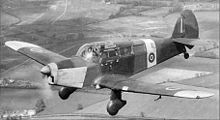De Havilland Gipsy Queen
| de Havilland Aircraft Company | |
|---|---|
|
de Havilland Gipsy Queen 70-4 at the Royal Air Force Museum Cosford |
|
| Gipsy Queen | |
| Production period: | 1936-1950 |
| Manufacturer: | de Havilland Aircraft Company |
| Developing country: |
|
| First run: | 1936 |
| Working principle: | Otto |
| Motor design: | In-line engine |
| Cylinder: | 6th |
| Valve control: | top steered |
| Drilling: | 118 mm |
| Hub: | 140 mm |
| Displacement: | 9186 cm 3 |
| Compression: | 6.5: 1 |
| Mixture preparation: | Carburetor |
| Engine charging: | compressor |
| Cooling system: | Air cooling |
| Lubrication system: | Dry sump lubrication |
| Power: | 155 kW |
| Dimensions: | 220 kg |
| Previous model: | de Havilland Gipsy Six |
| Successor: | none |
The de Havilland Gipsy Queen is a six-cylinder in- line engine from the British manufacturer de Havilland Aircraft Company . It was developed on the basis of the de Havilland Gipsy Six for use in military aircraft. The engines were built between 1936 and 1950 and are still operated in vintage de Havilland aircraft today .
Versions
- Gipsy Queen I.
- Military version of the Gipsy Six II with a rated output of 205 hp (151 kW ); Wedge crankshaft with fixed propellers ; developed in 1936; very few copies built
- Gipsy Queen II
- Military version of the Gipsy Six II with an output of 210 hp (154 kW); reinforced crankcase ; Crankshaft with variable pitch propeller ; developed in 1936
- Gipsy Queen III
- Military version of the Gipsy Six with an output of 200 hp (147 kW); reinforced crankcase; conical crankshaft for rigid propellers; developed 1940; 1358 copies built. Most of the specimens were equipped with a very simple engine cover without any auxiliary drives.
- Gipsy Queen IV
- Mechanically charged version with the designation Gipsy Queen IIIS, from June 1944 Gipsy Queen 50; developed in 1941. Only a few copies were built. This engine was advertised extensively, but never went into series production as it was replaced by the completely newly developed Queen 30.

Engines with a displacement of 10,180 cm³
- Gipsy Queen 30
- Output 240 hp (177 kW); developed in 1946; 1762 copies built
- Gipsy Queen 30-2
- Output 240 hp (177 kW); developed in 1946
- Gipsy Queen 30-3
- Output 240 hp (177 kW); developed in 1946
- Gipsy Queen 30-4
- Output 240 hp (177 kW); developed in 1946
- Gipsy Queen 32
- Output 240 hp (177 kW); developed in 1946
- Gipsy Queen 33
- Pusher version of the Gipsy Queen 30
- Gipsy Queen 34
- Gipsy Queen 50
- Output 295 hp (217 kW); mechanical charged; developed in 1944; 14 copies built
- Gipsy Queen 51
- like Gipsy Queen 50
- Gipsy Queen 70-1
- Mechanical charging with propeller gear ; 1889 copies built
- Gipsy Queen 70-2
- Output 380 hp (279 kW); Mechanical charging with propeller gear
- Gipsy Queen 70-3
- Output 380 hp (279 kW); Mechanical charging with propeller gear
- Gipsy Queen 70-4
- Output 340 hp (250 kW); Mechanical charging with propeller gear
- Gipsy Queen 71
- Output 330 hp (243 kW); Mechanical charging with propeller gear; developed in 1950
use
- Breda Ba.44
- Cierva W.9
- Fiat G.46 to and G.46-2
- de Havilland Dove
- de Havilland Dragon Rapide
- de Havilland Heron
- Handley Page Marathon
- Heston A.2 / 45
- Miles mentor
- Miles Merchantman
- Parnall Heck
- Parnall 382
- Percival Merganser
- Percival Prentice
- Percival Proctor
- Planet Satellite
- Scottish Aviation Pioneer
- Short Sealand
- Youngman-Baynes High Lift
Preserved copies
Of the eleven built, registered in the UK de Havilland DH.104 Dove , powered by a Gipsy Queen, only two were airworthy in 2011 . The Gipsy Queen II powered Percival Mew Gull with the registration G-AEXF is owned by the Shuttleworth Collection in Old Warden and is flown regularly at aviation shows .
Furthermore, various copies are exhibited in the following museums:
- Australian National Aviation Museum (Queen 30)
- de Havilland Aircraft Heritage Center
- Evergreen Aviation & Space Museum (Queen 70 Mk.2)
- Fleet Air Arm Museum on the RNAS Yeovilton
- Museo Nacional de Aeronáutica de Argentina (Queen 70-3)
- Royal Air Force Museum Cosford
- Imperial War Museum Duxford
- Montrose Air Station Heritage Center
- RAFFA Aviation Museum in Perth
See also
literature
- Jane's Fighting Aircraft of World War II . Studio Editions Ltd, London 1989, ISBN 0-517-67964-7 (English).
- Alex Lumsden: British Piston Engines and their Aircraft . Airlife Publishing, Marlborough 2003, ISBN 1-85310-294-6 (English).
- Bill Gunston: Development of Piston Aero Engines . Patrick Stephens Limited, 1999, ISBN 978-1-85260-619-0 (English).
Web links
Individual evidence
- ↑ Jane's Fighting Aircraft of World War II . Studio Editions Ltd, London 1989, ISBN 0-517-67964-7 , pp. 275 (English).
- ^ Bill Gunston: Development of Piston Aero Engines . Patrick Stephens Limited, 1999, ISBN 978-1-85260-619-0 , pp. 139 (English).
- ^ Register of the Civil Aviation Authority , query of April 21, 2011
- ↑ 1936 Percival Mew Gull. Shuttleworth Collection, accessed June 12, 2020 .

